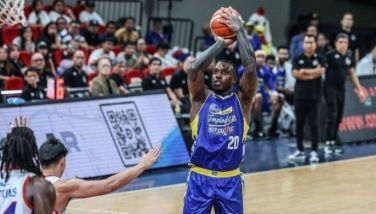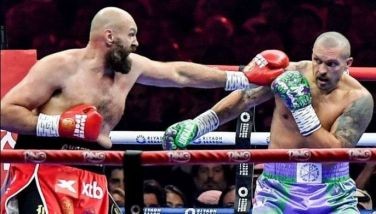Pinoy in FIBA Hall of Fame
MIES – There’s only one Filipino inducted in the FIBA Hall of Fame and Dionisio (Chito) Calvo was in the first batch enshrined in 2007, a tribute to the Philippines’ love for basketball.
Visiting the FIBA House of Basketball is quite an experience. It’s a four-floor building shaped in the form of a hand, symbolizing team spirit and unity, with a steel structure designed like a woven basketball net on an 8,500 square meter property. From Geneva, the drive is only 10 minutes to this Swiss village with a population of 2,000. You can’t miss the sign on the highway pointing to the building that has a 3x3 outdoor court and two busts of former secretaries-general William Jones and Borislav Stankovic at the front.
FIBA inaugurated a basketball museum in Alcobendas, Madrid in 1991 and started a tradition of inducting Hall of Famers every two years starting in 2007. The five-storey museum was home to a library with over 10,000 books and 950 magazines from over 65 countries on basketball. The library was named in honor of Spanish coaching legend Pedro Ferrandiz whose career was highlighted by 12 Spanish league and four Euroleague championships.
In 2013, FIBA opened the House of Basketball and moved its Hall of Fame from Madrid to Switzerland. The Ferrandiz library was also relocated although thousands of publications remained in the Alcobendas museum. The House of Basketball is where FIBA holds office and has 1,000 square meters of space devoted to an exhibition and event area named in honor of basketball’s inventor Dr. James Naismith. It also has an 80-seat restaurant, underground parking for 50 vehicles and eight state-of-the-art conference rooms. The building features 3,000 square meters of glass windows, 300 square meters of solar panels covering the roof, 170 tons of steel for the 40-meter long bridge structures, 120 work stations for 90 FIBA staff and 30 extra work stations for external organizations and over 40,000 objects representing basketball’s history and culture.
The Hall of Fame display shows uniforms, shoes and photographs of the inductees in four categories – players, referees, coaches and contributors. So far, the inductees are 33 male and 11 female players, 14 referees, 20 coaches and 33 contributors, including Calvo. Among the Hall of Famers are Oscar Robertson, David Robinson, Drazen Petrovic, Oscar Schmidt, Dean Smith, Pete Newell, Alexander Gomelsky and Hank Iba. The only Asian Hall of Famers are Calvo, Yoshimo Ueda of Japan and Yoon Duk Joo of South Korea. A candidate for enshrinement is the late two-time FIBA president Gonzalo (Lito) Puyat. SBP executive director Sonny Barrios said he will take up adding Caloy Loyzaga, widely considered as the greatest Filipino basketball player ever, in the candidates’ list for induction with FIBA. Loyzaga was cited as one of the world’s 10 best players after leading the Philippines to third place at the 1954 FIBA World Cup in Rio de Janeiro.
Calvo died in 1977 at 74. He represented the Philippines as a swimmer at the 1921 and 1923 Far Eastern Games and played with Lou Salvador on the national basketball team that took the gold medal at the 1925 edition. In 1936, Calvo coached the Philippines to fifth place at the Berlin Olympics. It remains the highest finish ever by an Asian country in Olympic basketball. In 1948, Calvo was back on the bench at the London Olympics where the Philippines made Olympic history by becoming the first team ever to score at least 100 points in a game, beating Iraq, 102-30.
Calvo organized the MICAA, the PBA’s precursor, in 1938 and became the first FIBA Asia (then known as the Asian Basketball Confederation) secretary-general in 1960. He was also the Philippine football coach at the 1934 Far Eastern and 1954 Asian Games. In the college leagues, Calvo coached the basketball teams of UP, San Beda, UST and La Salle.
Aside from Calvo’s enshrinement, the House of Basketball has other Philippine-related features. For instance, the SBP contact details are found on a visual screen at a click of a button as visitors enter the building. The Philippine marker is prominently situated at the top of a steel link in a basketball net-like structure where FIBA’s 215 member countries are listed with New Zealand directly below. A basketball autographed by the Gilas team that participated at the 2014 World Cup is on exhibit. Also on display are a designated chair honoring FIBA Central Board member and SBP president Manny V. Pangilinan, a commemorative banner of the 1978 World Cup held in Manila and the gold medal awarded at the 1978 World Cup showing the tournament logo with a graphic depiction of the Philippine flag.
The display area includes sections on the Olympics with medals and torches from different editions, equipment and venue centers with actual rims, memorabilia with early basketballs, uniforms, shoes and the first basket made of wood in 1891 and the World Cups for men and women with medals, uniforms, basketballs and shoes. There are exhibits of basketball board games dating back to the pre-War era, the 2016 Rio Olympics with a souvenir cap and mascot doll and the 1992 US Dream Team. A modern feature is an interactive booth where visitors check their knowledge of rules, test their skills and take a photo with the Naismith World Cup trophy. Other items on display are a full-size 3-D portrait of 2014 World Cup MVP Kyrie Irving and Shaquille O’Neal’s size 23 basketball shoes.
The House of Basketball is open from Monday to Friday, 10 a.m. to 4 p.m. and entrance is free or charge. “The philosophy of the building is simple, modern open, transparent and functional,” said FIBA secretary-general Patrick Baumann. “It is a place where the world of basketball meets and shapes the future of our sport. It also reminds us of basketball’s rich history. The exhibition is designed to tell people who we are and what we do. Nobody is excluded, everybody is welcome.”
- Latest
- Trending































